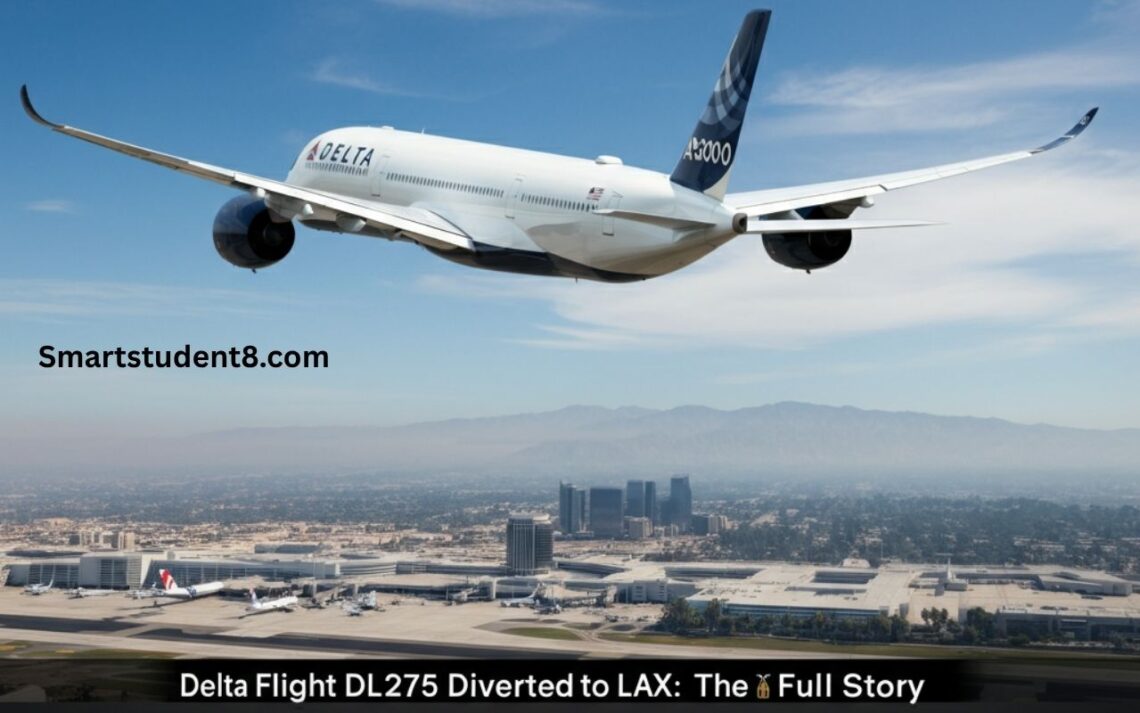Imagine settling in for a long-haul flight, headphones on, ready for the 13-hour journey from Detroit to Tokyo. You’re several hours in, soaring high above the vast expanse of the northern Pacific Ocean, when the flight path on the screen in front of you begins to make an unexpected, sweeping turn. This was the reality for passengers aboard Delta Flight DL275 on May 27, 2025. What was meant to be a routine transatlantic crossing became a multi-hour detour to Los Angeles International Airport (LAX). As an aviation enthusiast who has spent countless hours tracking flights and studying operational procedures, an event like this immediately captures my attention. It’s a powerful reminder of the complex, safety-first decision-making that happens behind the cockpit door, often thousands of feet in the air and far from land. These diversions aren’t just lines on a map; they are stories of professionalism, technology, and the unwavering commitment to passenger safety. This article will unpack the entire incident, from the technical fault that triggered the turn to the intricate logistics of handling hundreds of stranded passengers.
What Exactly Happened on Delta Flight DL275?
Delta Flight DL275, operated by a state-of-the-art Airbus A350-900 (registration N508DN), departed Detroit (DTW) on schedule, embarking on its journey to Tokyo Haneda (HND). For the first few hours, everything was normal. The aircraft climbed to its cruising altitude and headed northwest over Canada and Alaska, preparing to cross the Bering Sea. However, as the flight progressed over this remote and icy region, the flight crew received an alert from the aircraft’s monitoring systems. The notification pointed to a malfunction in a critical safety component: the engine anti-ice system on one of the powerful Rolls-Royce Trent XWB engines. At this point, the pilots, along with Delta’s operations center, were faced with a critical decision. Continuing a 13-hour flight over a vast ocean with a compromised safety system was not a viable option. The crew initiated a turn, transforming the flight path into a long, shallow arc heading southeast. Their new destination was Los Angeles (LAX), an airport nearly five hours away, but one that was perfectly equipped to handle the situation. The A350 landed safely on runway 06R at LAX in the early morning hours of May 28, with no injuries to passengers or crew.
The Culprit: A Failure in the Engine Anti-Ice System
To understand the gravity of the situation, it’s essential to know what the engine anti-ice system does. When an aircraft flies at high altitudes, it passes through air that is often well below freezing and can contain supercooled water droplets. These droplets can freeze instantly on contact with a cold surface, leading to ice buildup. Ice accretion on engine components, particularly the fan blades and nacelle inlets, can be extremely dangerous. It can disrupt the smooth flow of air into the engine, causing it to lose power, operate erratically, or, in a worst-case scenario, shut down completely. Large chunks of ice can also break off and be ingested by the engine, causing catastrophic damage.
The engine anti-ice system prevents this by using hot air bled from the engine’s compressor section. This hot air is ducted to the engine cowl and other critical surfaces, warming them enough to prevent ice from forming. The system is a cornerstone of aviation safety, especially for flights over cold regions like the North Pacific. A malfunction means this protection is compromised. While modern aircraft like the A350 have multiple layers of redundancy, a fault in an anti-ice system is treated with the utmost seriousness. The decision to divert is not just a precaution; it is a mandatory safety procedure dictated by both the manufacturer and aviation regulators worldwide. The pilots of DL275 made the only correct call: get the aircraft to a suitable airport where the issue could be safely and thoroughly addressed.
Why Divert to LAX? The Logic Behind the Decision
When the decision to divert was made, DL275 was flying over a remote part of the world. On a map, other airports might have appeared geographically closer than Los Angeles. However, choosing a diversion airport involves much more than just finding the nearest strip of asphalt. The flight crew and the airline’s dispatchers must consider a complex set of variables, all centered around safety and operational capability. This is where my fascination with airline operations really kicks in, as it’s a masterclass in logistical planning under pressure.
An airport must be “suitable,” which means it meets several key criteria:
- Runway and Infrastructure: The airport must have a runway long enough and strong enough to accommodate a large, heavy widebody aircraft like the Airbus A350. It also needs appropriate gates and ground equipment to handle the plane once it lands.
- Maintenance and Technical Support: A diversion for a technical issue requires an airport with the right maintenance staff, tools, and spare parts. LAX is a major hub for Delta and has a significant maintenance base (TechOps). This means they have certified A350 mechanics and a likely inventory of parts for the Rolls-Royce Trent XWB engines. Diverting to a smaller, regional airport would have meant flying in specialists and parts, causing much longer delays.
- Passenger and Crew Logistics: A diverted long-haul flight means hundreds of passengers and a full flight crew are now stranded. A major international hub like LAX has the capacity to handle this. There are thousands of hotel rooms, extensive ground transportation options, and a large contingent of airline customer service staff to manage rebooking, meals, and accommodations for over 300 people.
- Customs and Immigration: Since DL275 was an international flight, it needed to land at an airport with customs and border protection facilities to process all passengers. LAX, as a primary international gateway, is perfectly equipped for this.
Considering these factors, the five-hour flight to LAX was the most logical and efficient choice. It ensured the aircraft could be repaired quickly by expert technicians and that the passengers could be cared for with minimal secondary disruption. The decision showcases a well-oiled operational machine that prioritizes not just immediate safety but also the complex recovery process that follows.
The Experience Onboard: Calm Professionalism Amidst Uncertainty
For the passengers, the first sign of trouble was likely the unexpected turn shown on the in-flight entertainment map, followed by an announcement from the captain. In these moments, the atmosphere in the cabin can shift from relaxed to anxious in an instant. Murmurs spread as people began to speculate about what might be happening. Having been on a flight that experienced a significant mechanical issue, I can tell you that your mind immediately jumps to the worst-case scenarios. It’s a deeply unsettling feeling to be suspended miles above the earth in a metal tube and know that something is not right. This is where the training and professionalism of the cabin crew become paramount.
Reports from the incident indicate that the Delta crew handled the situation with exemplary calmness and control. Flight attendants are trained extensively for these exact scenarios. Their primary role shifts from service to safety management. They moved through the cabin, offering reassurance, answering questions when they could, and projecting an aura of confidence. A calm crew leads to calm passengers. The flight deck also played a crucial role by providing clear, periodic updates. Explaining the nature of the problem (a technical issue), the plan (diverting to LAX for safety), and the expected arrival time helps to demystify the situation and manage passenger anxiety. While uncertainty lingered, the crew’s composed demeanor and consistent communication helped maintain order and prevent panic during the long diversion to the California coast. This human element is often the most critical factor in successfully managing an in-flight incident.
Delta’s Response: Managing the Aftermath
Once Flight DL275 was safely on the ground at LAX, Delta’s ground operations sprang into action. The airline’s response to a diversion is a crucial part of its customer service and a key factor in retaining passenger loyalty. The first priority was deplaning the passengers and processing them through customs. From there, the massive logistical challenge of managing the needs of several hundred displaced travelers began. Delta’s hub infrastructure at LAX was essential in this phase. The airline immediately began working to provide hotel accommodations, meal vouchers, and transportation for all affected passengers.
Communication remained a key priority. Delta used its mobile app, email, and airport agents to keep passengers informed about their new travel arrangements. Most passengers would have been rebooked on the next available flights to Tokyo or their final destinations. For an unexpected disruption of this scale, compensation is also standard practice. Passengers likely received frequent flyer miles, travel vouchers, or other forms of compensation as an apology for the significant inconvenience. While no one wants their travel plans upended, an airline’s response can make all the difference. By acting swiftly to provide for passengers’ basic needs and communicating transparently, Delta aimed to mitigate the frustration and demonstrate its commitment to customer care, even when things go wrong.
Aviation Safety: A System Built on Prevention
Incidents like the diversion of DL275 serve as a real-world stress test of the aviation industry’s multi-layered safety philosophy. While it may seem alarming, a diversion for a technical issue is actually a sign that the system is working exactly as it should. It demonstrates a culture where safety is not negotiable. Pilots are trained to always err on the side of caution. An engine anti-ice fault over the Pacific is a scenario where you don’t take chances. The decision to turn back, even if it meant hours of extra flying time and significant cost, was the only correct one.
This event also highlights the incredible reliability of modern aircraft. The Airbus A350, like all commercial airliners, is designed with immense redundancy. It can fly safely with one engine, and its systems are built with multiple backups. The issue was not that the plane was in imminent danger of falling out of the sky, but that a crucial layer of safety protection was compromised. The diversion was a proactive measure to prevent a potential problem from escalating in a hostile environment far from a suitable airport. Every flight that lands safely after an in-flight issue is a testament to the robust design of the aircraft, the rigorous training of the crews, and the conservative, safety-first procedures that govern global aviation.
The Role of Predictive Maintenance in Modern Aviation
While the diversion of Flight DL275 was handled successfully, the ultimate goal for airlines is to prevent such in-flight issues from happening in the first place. This is where the field of predictive maintenance is revolutionizing the industry. Modern aircraft like the A350 are flying data centers, equipped with thousands of sensors that monitor the health of every critical component in real-time. The Rolls-Royce Trent XWB engines, for example, transmit vast amounts of performance data to ground stations during every flight.
Airlines and manufacturers use this data for Engine Health Monitoring (EHM). Sophisticated algorithms analyze trends and look for subtle anomalies that indicate a component is degrading or likely to fail soon. This allows maintenance teams to proactively schedule repairs or replace parts during planned overnight stops, rather than having a failure occur mid-flight. Delta has invested heavily in this technology through its partnership with Airbus in the Skywise data platform and its own advanced predictive maintenance programs. The goal is to move from a reactive or scheduled maintenance model to a predictive one, catching faults before they can impact operations. While no system is perfect, predictive maintenance is drastically reducing the rate of in-flight technical issues, making air travel safer and more reliable every year. The DL275 incident will undoubtedly be fed back into this system to refine the algorithms and help prevent similar anti-ice system faults in the future.
Financial Implications of a Long-Haul Diversion
A diversion of this magnitude is not only a logistical headache but also a significant financial event for the airline. The costs add up quickly and come from multiple sources. First, there are the direct operational costs of the extra flight time. A widebody jet like the A350 costs thousands of dollars per hour to operate in fuel, crew salaries, and maintenance reserves. The five-hour detour to LAX represents a substantial unplanned expense. Add to that the landing and handling fees at the diversion airport.
Second, the costs of passenger care are considerable. Providing hotel rooms, meals, and transport for over 300 people for at least one night can easily run into the tens of thousands of dollars. Rebooking them on other flights, which may be full, can also involve buying tickets from other carriers. Then there is the cost of compensation, such as travel vouchers or bonus miles. Finally, there are the downstream network costs. The aircraft that diverted is now out of position, and so is its crew. This can cause a cascade of delays or cancellations for other flights that the plane and crew were scheduled to operate, leading to lost revenue. While the exact total can vary, a long-haul international diversion can easily cost an airline anywhere from $100,000 to well over $500,000, and sometimes more, depending on the circumstances. However, in the risk calculation of aviation, this cost is insignificant compared to the non-negotiable imperative of ensuring everyone’s safety.
Final Thoughts: A System That Works
The story of Delta Flight DL275’s diversion to LAX is more than just an interesting news item; it is a powerful case study in modern aviation. It showcases the synergy between advanced technology, rigorous procedure, and human expertise. From the sensors that detected the fault to the pilots who made the right call, the crew who kept passengers calm, and the ground teams who managed the aftermath, every part of the system performed as designed. As someone who trusts this system with my life every time I fly, it’s reassuring to see it work so effectively under pressure. While passengers experienced a significant disruption to their travel plans, they were kept safe. In the end, that is the only metric that truly matters. The empty skies of 2020 reminded us not to take air travel for granted, and incidents like this remind us of the incredible, often invisible, efforts that make it the safest mode of transportation in the world. The long, sweeping arc on the flight tracker was not a sign of failure, but a symbol of a safety culture that puts people first, always.





